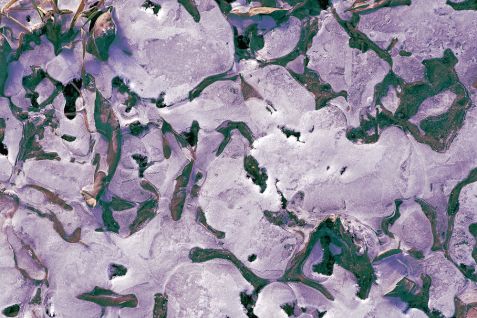MLZ is a cooperation between:
 > Technische Universität München
> Technische Universität München > Helmholtz-Zentrum Hereon
> Helmholtz-Zentrum Hereon
 > Forschungszentrum Jülich
> Forschungszentrum Jülich
MLZ is a member of:
 > LENS
> LENS > ERF-AISBL
> ERF-AISBL
MLZ on social media:

MLZ (eng)
Lichtenbergstr.1
85748 Garching
09.03.2021
Neutrons show, how water moves in permafrost

Aerial view of a permafrost landscape. With their measurements, scientists can now better understand the processes occurring in permafrost soils at the boundary layer between ice and clay material. © Henryk Niestrój/Pixabay
While ice skating, a thin liquid film forms on ice surfaces. This, along with other causes, is responsible for ice slipperiness. Scientists from the Max Planck Institute for Polymer Research have now investigated a related effect at interfaces between ice and porous clay minerals. Such interfaces are found in nature for example in permafrost. The results may help to better understand changes in frozen soils as temperatures rise.
For ice, so-called “surface melting” was postulated as early as the 19th century by Michael Faraday: Already below the actual melting point, i.e. 0 °C, a thin liquid film forms on the free surface because oft he interface between ice and air. Scientists led by Dr. Markus Mezger, group leader at the Max Planck Institute for Polymer Research and professor at the University of Vienna, have now studied this phenomenon in more detail at interfaces between ice and clay minerals.
Permafrost soils store a lot of water
In nature, this effect is particularly interesting in permafrost soils – i.e. soils that are permanently frozen. About a quarter of the land area in the northern hemisphere is covered by permafrost. These are composed of a mixture of ice and other materials. Microscopically thin platelets were formed over geological time by the weathering of clay minerals. Similar to a sponge, a lot of water can enter the narrow slit pores between the thin platelets, be stored there, and freeze. Therefore, there is a lot of contact area between ice and clay minerals. For every gram of clay mineral, there are about 10 square meters of surface area! This causes a comparatively high proportion of liquid water in the interfacially induced melt layer already below 0 °C.
Better understanding of the transport of pollutants in the soils
The researchers have now investigated how fast the water molecules move in the thin melt layer at the boundary between ice and clay mineral. This value, known as “self-diffusion,” is directly linked to the viscosity of the water. For three different minerals, it has been shown that the viscosity of water in the interface-induced melt layer is sometimes significantly higher than that of ordinary water – i.e., the molecules are limited in their ability to move because the layer is more viscous. These results may help to better understand various phenomena in the future, such as the mechanical stability of permafrost, the transport of plant nutrients and pollutants, and geochemical reactions such as ion exchange processes at ice/mineral interfaces.
Neutrons measure movements of the molecules
For their measurements, the Mainz scientists collaborated with partners from Technical University of Munich (TUM) at the Heinz Maier-Leibnitz Zentrum (MLZ) and the Institut Laue-Langevin in Grenoble, France. The neutrons generated in the research reactors there strike the sample at a certain speed. Similar to a ball bouncing back from a vehicle moving toward it at a higher speed, velocity measurements of the neutrons scattered from the sample allow conclusions to be drawn about the motion of the water molecules in the interface-induced premelting layer. The measurements at MLZ were led by Dr. Wiebke Lohstroh (TUM) at the time of flight spectrometer TOFTOF.
The results have now been published in the journal “Angewandte Chemie – International Edition”.
Original text: Dr. Christian Schneider / Max-Planck Institut für Polymerforschung
Original publication:
Hailong Li, Julian Mars, Wiebke Lohstroh, Michael Marek Koza, Hans‐Jürgen Butt, Markus Mezger. Water Mobility in the Interfacial Liquid Layer of Ice/Clay Nanocomposites. Angew. Chem. 133,2–9 (2021). DOI: 10.1002/anie.202013125
Contact:
Prof. Dr. Markus Mezger
Dynamik Kondensierter Systeme
Boltzmanngasse 5
1090 Wien,
T: +43-1-4277-72904
markus.mezger@univie.ac.at
MLZ is a cooperation between:
 > Technische Universität München
> Technische Universität München > Helmholtz-Zentrum Hereon
> Helmholtz-Zentrum Hereon
 > Forschungszentrum Jülich
> Forschungszentrum Jülich
MLZ is a member of:
 > LENS
> LENS > ERF-AISBL
> ERF-AISBL
MLZ on social media:


